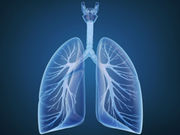CT scan modified classification in 58.6 percent of patients presenting to ER with suspected CAP
THURSDAY, Oct. 29, 2015 (HealthDay News) — Computed tomography (CT) findings affect the diagnosis and management of suspected community-acquired pneumonia (CAP), according to a study published in the Oct. 15 issue of the American Journal of Respiratory and Critical Care Medicine.
Yann-Erick Claessens, M.D., Ph.D., from the Centre Hospitalier Princesse Grace in Monaco, and colleagues examined whether early multidetector chest CT scan affects diagnosis and management of patients visiting the emergency department with suspected CAP. Three hundred nineteen prospectively enrolled patients underwent multidetector chest CT within four hours. Emergency physicians established the probability of CAP diagnosis and therapeutic plans before and after CT scan results. The final CAP classification was established on day 28 by an adjudication committee.
The researchers identified a parenchymal infiltrate in 188 patients. CAP was initially classified as definite, probable or possible, and excluded in 44.8, 53.8, and 1.2 percent, respectively. Thirty-three percent of patients without infiltrate on chest radiograph were found to have parenchymal infiltrate on CT scan; CT scan also excluded CAP in 29.8 percent of the 188 patients with parenchymal infiltrate on radiograph. CT modified classification in 58.6 percent of patients, resulting in classification of definite CAP in 50.8 percent and exclusion of CAP in 28.8 percent. Eighty percent of these modifications agreed with the final CAP classification of the adjudication committee.
“Early CT scan findings complementary to chest radiograph markedly affect both diagnosis and clinical management,” the authors write.
Full Text (subscription or payment may be required)
Copyright © 2015 HealthDay. All rights reserved.








